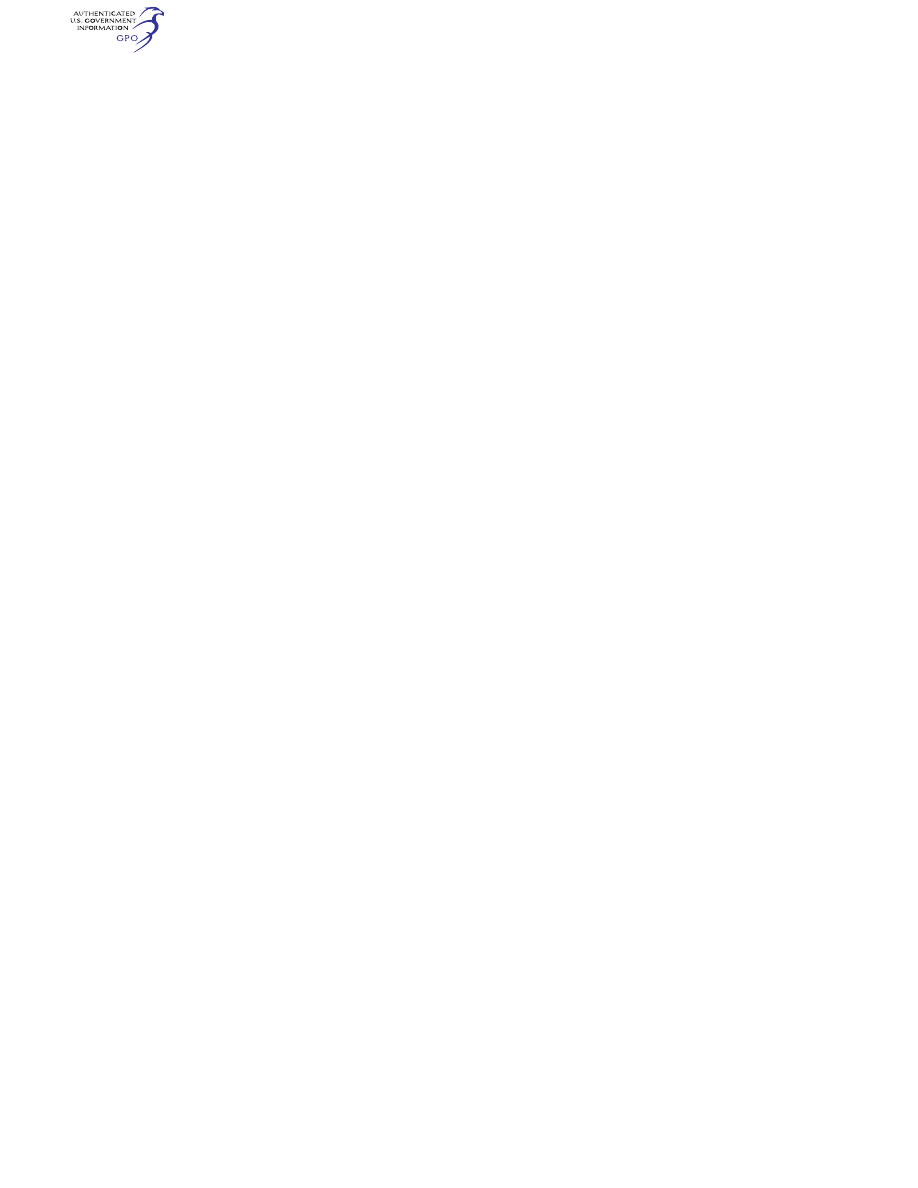
150
14 CFR Ch. I (1–1–24 Edition)
§ 21.95
(ii) Designated for dispensing fire
fighting materials to which § 36.1583 of
this chapter does not apply, or
(iii) U.S. registered, and that had
flight time prior to January 1, 1955 or
(iv) Land configured aircraft recon-
figured with floats or skis. This recon-
figuration does not permit further ex-
ception from the requirements of this
section upon any acoustical change not
enumerated in § 21.93(b).
(4) Helicopters except:
(i) Those helicopters that are des-
ignated exclusively:
(A) For ‘‘agricultural aircraft oper-
ations’’, as defined in § 137.3 of this
chapter, as effective on January 1, 1966;
(B) For dispensing fire fighting mate-
rials; or
(C) For carrying external loads, as
defined in § 133.1(b) of this chapter, as
effective on December 20, 1976.
(ii) Those helicopters modified by in-
stallation or removal of external equip-
ment. For purposes of this paragraph,
‘‘external equipment’’ means any in-
strument, mechanism, part, apparatus,
appurtenance, or accessory that is at-
tached to, or extends from, the heli-
copter exterior but is not used nor is
intended to be used in operating or
controlling a helicopter in flight and is
not part of an airframe or engine. An
‘‘acoustical change’’ does not include:
(A) Addition or removal of external
equipment;
(B) Changes in the airframe made to
accommodate the addition or removal
of external equipment, to provide for
an external load attaching means, to
facilitate the use of external equip-
ment or external loads, or to facilitate
the safe operation of the helicopter
with external equipment mounted to,
or external loads carried by, the heli-
copter;
(C) Reconfiguration of the helicopter
by the addition or removal of floats
and skis;
(D) Flight with one or more doors
and/or windows removed or in an open
position; or
(E) Any changes in the operational
limitations placed on the helicopter as
a consequence of the addition or re-
moval of external equipment, floats,
and skis, or flight operations with
doors and/or windows removed or in an
open position.
(5) Tiltrotors.
(c) For purposes of complying with
part 34 of this chapter, any voluntary
change in the type design of the air-
plane or engine which may increase
fuel venting or exhaust emissions is an
‘‘emissions change.’’
[Amdt. 21–27, 34 FR 18363, Nov. 18, 1969]
E
DITORIAL
N
OTE
: For F
EDERAL
R
EGISTER
ci-
tations affecting § 21.93, see the List of CFR
Sections Affected, which appears in the
Finding Aids section of the printed volume
and at
www.govinfo.gov.
§ 21.95
Approval of minor changes in
type design.
Minor changes in a type design may
be approved under a method acceptable
to the FAA before submitting to the
FAA any substantiating or descriptive
data.
§ 21.97
Approval of major changes in
type design.
(a) An applicant for approval of a
major change in type design must—
(1) Provide substantiating data and
necessary descriptive data for inclu-
sion in the type design;
(2) Show that the change and areas
affected by the change comply with the
applicable requirements of this sub-
chapter, and provide the FAA the
means by which such compliance has
been shown; and
(3) Provide a statement certifying
that the applicant has complied with
the applicable requirements.
(b) Approval of a major change in the
type design of an aircraft engine is lim-
ited to the specific engine configura-
tion upon which the change is made
unless the applicant identifies in the
necessary descriptive data for inclu-
sion in the type design the other con-
figurations of the same engine type for
which approval is requested and shows
that the change is compatible with the
other configurations.
[Amdt. 21–40, 39 FR 35459, Oct. 1, 1974, as
amended by Amdt. 21–92, 74 FR 53387, Oct. 16,
2009; Amdt. 21–96, 77 FR 71695, Dec. 4, 2012]
§ 21.99
Required design changes.
(a) When an Airworthiness Directive
is issued under Part 39 the holder of
the type certificate for the product
concerned must—
VerDate Sep<11>2014
09:06 Jun 28, 2024
Jkt 262046
PO 00000
Frm 00160
Fmt 8010
Sfmt 8002
Y:\SGML\262046.XXX
262046
jspears on DSK121TN23PROD with CFR

151
Federal Aviation Administration, DOT
§ 21.101
(1) If the FAA finds that design
changes are necessary to correct the
unsafe condition of the product, and
upon his request, submit appropriate
design changes for approval; and
(2) Upon approval of the design
changes, make available the descrip-
tive data covering the changes to all
operators of products previously cer-
tificated under the type certificate.
(b) In a case where there are no cur-
rent unsafe conditions, but the FAA or
the holder of the type certificate finds
through service experience that
changes in type design will contribute
to the safety of the product, the holder
of the type certificate may submit ap-
propriate design changes for approval.
Upon approval of the changes, the man-
ufacturer must make information on
the design changes available to all op-
erators of the same type of product.
[Doc. No. 5085, 29 FR 14567, Oct. 24, 1964, as
amended by Amdt. 21–3, 30 FR 8826, July 24,
1965]
§ 21.101
Designation of applicable reg-
ulations.
(a) An applicant for a change to a
type certificate must show that the
change and areas affected by the
change comply with the airworthiness
requirements applicable to the cat-
egory of the product in effect on the
date of the application for the change
and with parts 34 and 36 of this chapter.
Exceptions are detailed in paragraphs
(b) and (c) of this section.
(b) Except as provided in paragraph
(g) of this section, if paragraphs (b)(1),
(2), or (3) of this section apply, an ap-
plicant may show that the change and
areas affected by the change comply
with an earlier amendment of a regula-
tion required by paragraph (a) of this
section, and of any other regulation
the FAA finds is directly related. How-
ever, the earlier amended regulation
may not precede either the cor-
responding regulation included by ref-
erence in the type certificate, or any
regulation in §§ 25.2, 27.2, or 29.2 of this
chapter that is related to the change.
The applicant may show compliance
with an earlier amendment of a regula-
tion for any of the following:
(1) A change that the FAA finds not
to be significant. In determining
whether a specific change is signifi-
cant, the FAA considers the change in
context with all previous relevant de-
sign changes and all related revisions
to the applicable regulations incor-
porated in the type certificate for the
product. Changes that meet one of the
following criteria are automatically
considered significant:
(i) The general configuration or the
principles of construction are not re-
tained.
(ii) The assumptions used for certifi-
cation of the product to be changed do
not remain valid.
(2) Each area, system, component,
equipment, or appliance that the FAA
finds is not affected by the change.
(3) Each area, system, component,
equipment, or appliance that is af-
fected by the change, for which the
FAA finds that compliance with a reg-
ulation described in paragraph (a) of
this section would not contribute ma-
terially to the level of safety of the
product or would be impractical.
(c) An applicant for a change to an
aircraft (other than a rotorcraft) of
6,000 pounds or less maximum weight,
to a non-turbine rotorcraft of 3,000
pounds or less maximum weight, to a
level 1 low-speed airplane, or to a level
2 low-speed airplane may show that the
change and areas affected by the
change comply with the regulations in-
cluded in the type certificate. However,
if the FAA finds that the change is sig-
nificant in an area, the FAA may des-
ignate compliance with an amendment
to the regulation incorporated by ref-
erence in the type certificate that ap-
plies to the change and any regulation
that the FAA finds is directly related,
unless the FAA also finds that compli-
ance with that amendment or regula-
tion would not contribute materially
to the level of safety of the product or
would be impractical.
(d) If the FAA finds that the regula-
tions in effect on the date of the appli-
cation for the change do not provide
adequate standards with respect to the
proposed change because of a novel or
unusual design feature, the applicant
must also comply with special condi-
tions, and amendments to those special
conditions, prescribed under the provi-
sions of § 21.16, to provide a level of
safety equal to that established by the
VerDate Sep<11>2014
09:06 Jun 28, 2024
Jkt 262046
PO 00000
Frm 00161
Fmt 8010
Sfmt 8002
Y:\SGML\262046.XXX
262046
jspears on DSK121TN23PROD with CFR

